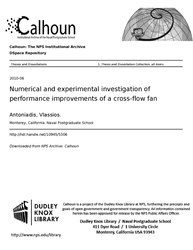File:Numerical and experimental investigation of performance improvements of a cross-flow fan (IA numericalndexper109455306).pdf

Original file (1,275 × 1,650 pixels, file size: 3.45 MB, MIME type: application/pdf, 126 pages)
Captions
Captions
Summary[edit]
| Numerical and experimental investigation of performance improvements of a cross-flow fan
( |
||
|---|---|---|
| Author |
Antoniadis, Vlassios. |
|
| Title |
Numerical and experimental investigation of performance improvements of a cross-flow fan |
|
| Publisher |
Monterey, California. Naval Postgraduate School |
|
| Description |
The cross-flow fan has an inherent ability to provide thrust to an airfoil as well as provide boundary layer control. The thrust can be easily vectored and usually the cross-flow fan is fully embedded within the airfoil, making its operation relatively safe. Those characteristics make it very favorable as a propulsive means for a vertical takeoff and landing (VTOL) aircraft. However, further design improvements are needed for competitive comparison with existing conventional aircraft propulsion methods. The baseline configuration was scaled from a 12-inch diameter, 30-bladed rotor developed by Vought Systems in the 1970s to a 6-inch rotor as a more realistic size for integration into a propulsive wing. Using the computational fluid dynamics (CFD) software, ANSYS CFX, previous baseline configuration models were validated at full-speed range to verify the software's prediction. Then, a model with the cross-flow fan embedded at the trailing edge was built and different configurations were examined. An attempt was made to improve the performance of the cross-flow fan embedded airfoil by thrust and thrust-to-power ratio, and lift and drag forces were calculated. CFD results have shown that a rotor with fewer blades can improve performance and a 22-bladed rotor was selected and examined experimentally. Results were compared with the baseline 30-bladed rotor. Subjects: Mechanical engineering; Computer programs |
|
| Language | English | |
| Publication date | June 2010 | |
| Current location |
IA Collections: navalpostgraduateschoollibrary; fedlink |
|
| Accession number |
numericalndexper109455306 |
|
| Source | ||
| Permission (Reusing this file) |
This publication is a work of the U.S. Government as defined in Title 17, United States Code, Section 101. As such, it is in the public domain, and under the provisions of Title 17, United States Code, Section 105, may not be copyrighted. | |
Licensing[edit]
| Public domainPublic domainfalsefalse |
This work is in the public domain in the United States because it is a work prepared by an officer or employee of the United States Government as part of that person’s official duties under the terms of Title 17, Chapter 1, Section 105 of the US Code.
Note: This only applies to original works of the Federal Government and not to the work of any individual U.S. state, territory, commonwealth, county, municipality, or any other subdivision. This template also does not apply to postage stamp designs published by the United States Postal Service since 1978. (See § 313.6(C)(1) of Compendium of U.S. Copyright Office Practices). It also does not apply to certain US coins; see The US Mint Terms of Use.
|
 | |
| This file has been identified as being free of known restrictions under copyright law, including all related and neighboring rights. | ||
https://creativecommons.org/publicdomain/mark/1.0/PDMCreative Commons Public Domain Mark 1.0falsefalse
File history
Click on a date/time to view the file as it appeared at that time.
| Date/Time | Thumbnail | Dimensions | User | Comment | |
|---|---|---|---|---|---|
| current | 11:56, 23 July 2020 |  | 1,275 × 1,650, 126 pages (3.45 MB) | Fæ (talk | contribs) | FEDLINK - United States Federal Collection numericalndexper109455306 (User talk:Fæ/IA books#Fork8) (batch 1993-2020 #23658) |
You cannot overwrite this file.
File usage on Commons
The following page uses this file:
Metadata
This file contains additional information such as Exif metadata which may have been added by the digital camera, scanner, or software program used to create or digitize it. If the file has been modified from its original state, some details such as the timestamp may not fully reflect those of the original file. The timestamp is only as accurate as the clock in the camera, and it may be completely wrong.
| Short title | Numerical and experimental investigation of performance improvements of a cross-flow fan |
|---|---|
| Image title | |
| Author | Antoniadis, Vlassios. |
| Software used | Antoniadis, Vlassios. |
| Conversion program | Adobe PDF Library 9.0 |
| Encrypted | no |
| Page size | 612 x 792 pts (letter) |
| Version of PDF format | 1.4 |

